Expert Advice
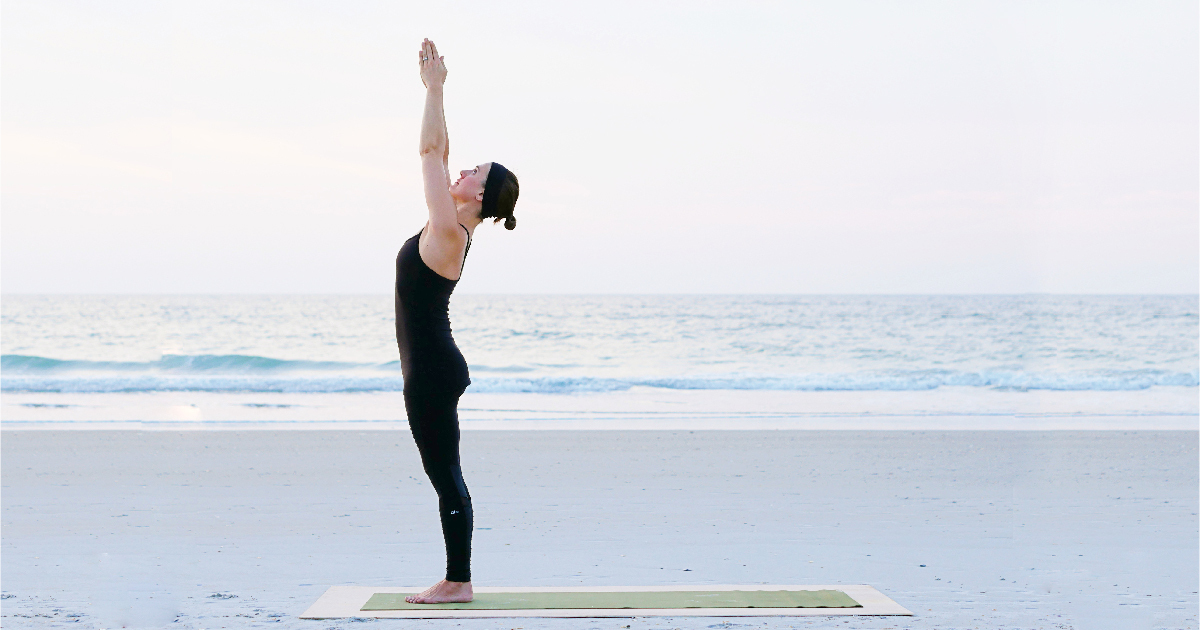
Acella Pharmaceuticals, LLC, is partnering with Lexi Hawks, an E-RYT 500 Hr Yoga Alliance Certified Teacher, to bring greater awareness to the importance of thyroid care and education. This post was sponsored by Acella Pharmaceuticals and should not be construed as medical advice. Please talk to your doctor about your individual medical situation.
Disclaimer: The information provided is for educational purposes only and does not substitute professional medical advice. Consult a medical professional or healthcare provider before beginning any exercise, fitness, diet, or nutrition routine.
For those managing hypothyroidism or Hashimoto’s disease, inflammation is a symptom often reported by patients. Studies have shown that a regular yoga practice may be a viable way to reduce inflammation.1
Reducing or preventing chronic inflammation in the body can help decrease the chances of damaging health issues. We can lower inflammation by addressing how we eat and process stress and how often we exercise. Yoga is both a science and an art and offers insight, guidance, and instruction in each of these areas. Today, we will explore a yoga sequence that, when performed regularly, may reduce chronic inflammation.
Regular exercise can help prevent inflammation. Ideally, we need a combination of aerobic exercises (30 minutes to 45 minutes, performed four to five times a week) and anaerobic exercise (10 minutes to 25 minutes, performed four to five times a week). Luckily some styles of yoga can address both of these needs.
Sun Salutation Sequence
One of my favorites is a series of yoga postures that are put together to make the Sun Salutation (Surya Namaskar). The Sun Salutation is done as one pose per breath, creating a flowing, rhythmic, moving meditation. Doing yoga poses in this way creates heat in the body, increases the heart rate and respiration, and can provide an aerobic experience. We sync our energy with the solar energy of the sun. Following the Sun Salutation, we can add other yoga poses to our practice or slowly transition into one of the most important yoga poses that aids in stress reduction: Shavasana (Corpse Pose). This combination of yoga postures and concepts is ideal for reducing inflammation.
Surya Namaskar is presented below with the breath cue that initiates the movement and a photo of the yoga pose. When you first learn the Sun Salutation, slow the postures down and take a few breaths to explore each shape and the transitions from one to the next. Once you are familiar with the shapes, try speeding things up to one breath per movement (through the nose). You can do as many Sun Salutations as you wish … 3, 5, 7, 9,… 108 or more! It is very important that the poses are done with proper breathing. The sequence can feel vigorous, but as with any exercise, you want to be sure the breath is not strained.

Mountain Pose
Join the feet and legs. Connect all four corners of the feet to the ground. Distribute the weight evenly between the balls and heels of the feet. Press down through the feet and lift from the ankles to the hips. Lift the sides of the body from the outer hips to the sides of chest. Keep the spine long and the chest and upper back equally broad. Lengthen the back of the neck, with the chin staying neutral. Focus the gaze straight ahead.
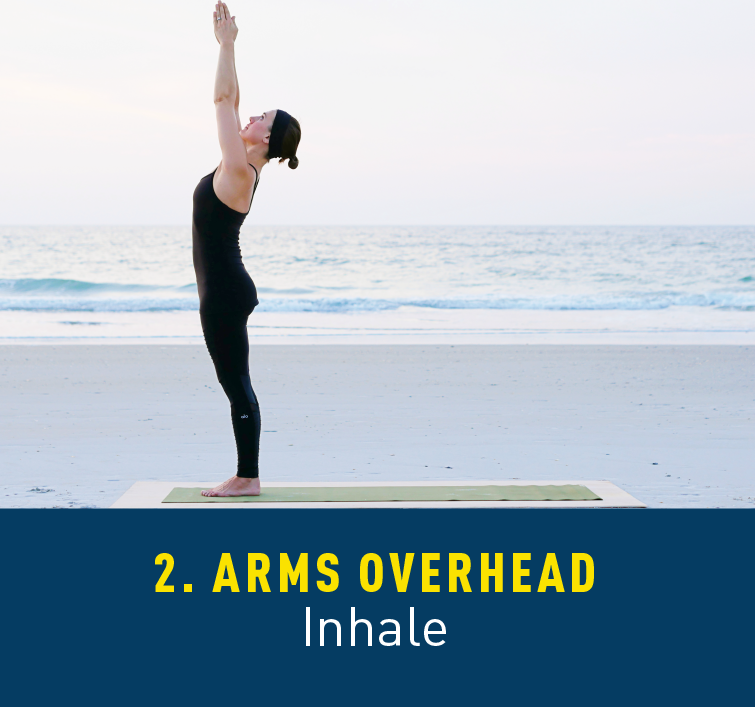
Arms Overhead
Stay in Mountain Pose and reach arms overhead, either shoulder-distance apart with palms facing each other, or bring palms together. Set your gaze on the thumbs.
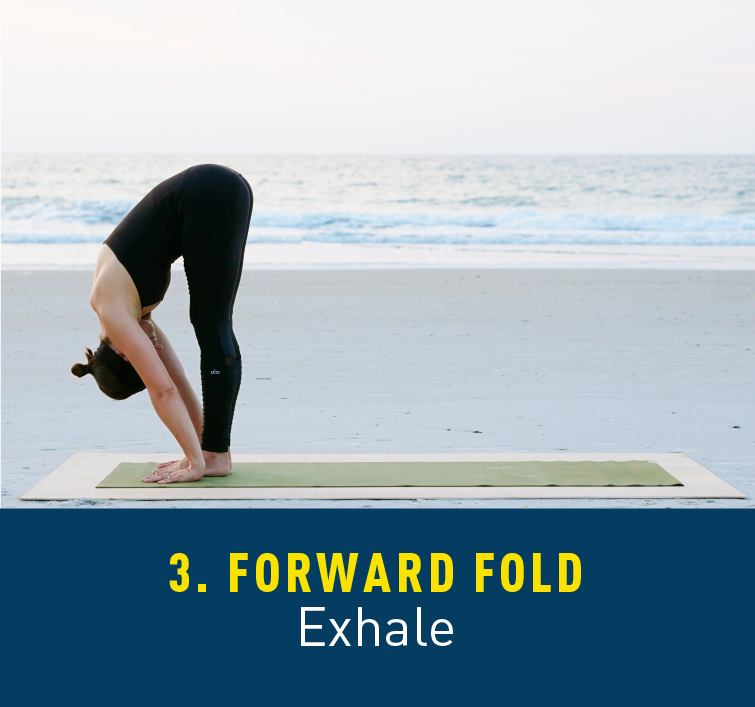
Forward Fold
Feet together or hip distance, connect all four corners of the feet with the ground. Palms press into floor, yoga blocks, or a chair seat if the legs feel tight. Distribute the weight evenly between the balls and heels of the feet, root firmly into the ground through feet and hands. Lift the muscles of the legs up from the ankles to the hips. The bend happens at the hips (not from the waist or lower back).
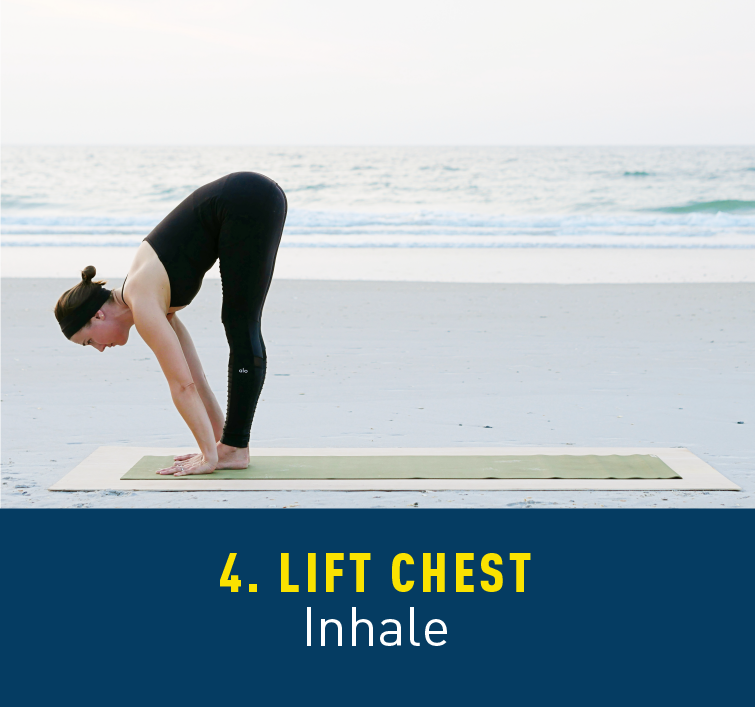
Lift Chest
From Forward Fold, lengthen the spine as the thighs engage. Pull the chest forward as the top of the thighs stay back. Take the gaze forward while keeping the back of the neck long. Step the feet back into a plank.
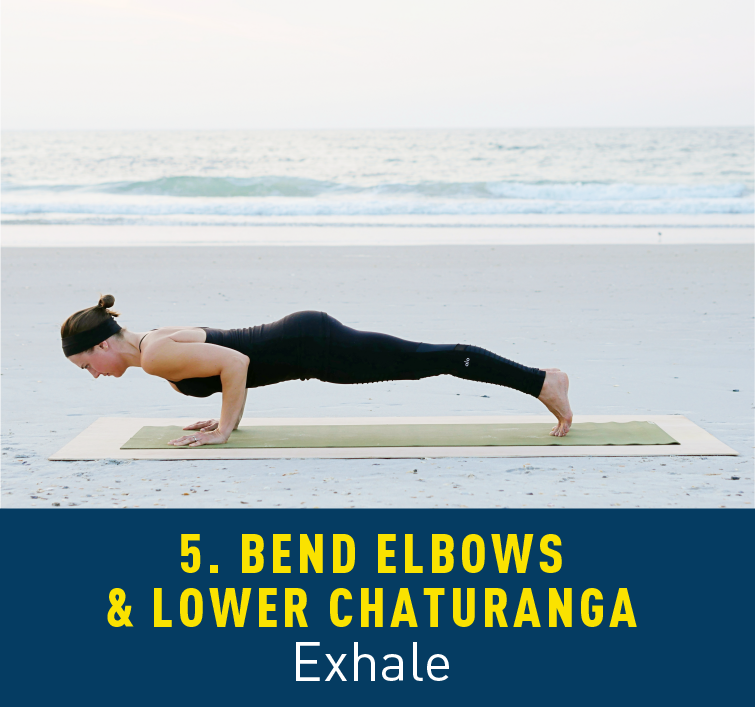
Bend Elbows and Lower Chaturanga
Palms press evenly and firmly into the ground. Bend elbows, move shoulders forward, align the elbows directly over the palms so that the arms make a 90-degree angle. Chest stays above or in line with elbows. The body hovers in one straight line over the ground, shoulder, and elbow in line as well. Look forward and keep the back of the neck long. This pose is VERY challenging. If you need to modify, then take a knee-down plank to release to the floor.
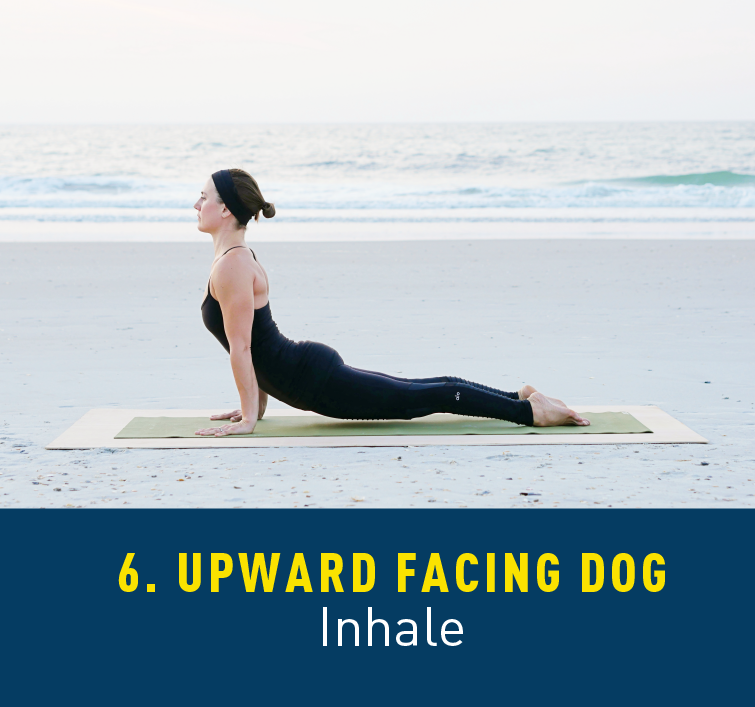
Upward Facing Dog
Lie prone on the mat, place the palms by the low ribs with elbows bent. Press the palms as well as the index finger and thumb firmly into the ground and slightly back, straighten arms. Press into the tops of the feet or tuck the toes under for additional leg support. Extend through neck and lift chin as you keep the neck long. Gaze forward and slightly up or at your nose. (Modify with Cobra Pose, if needed)
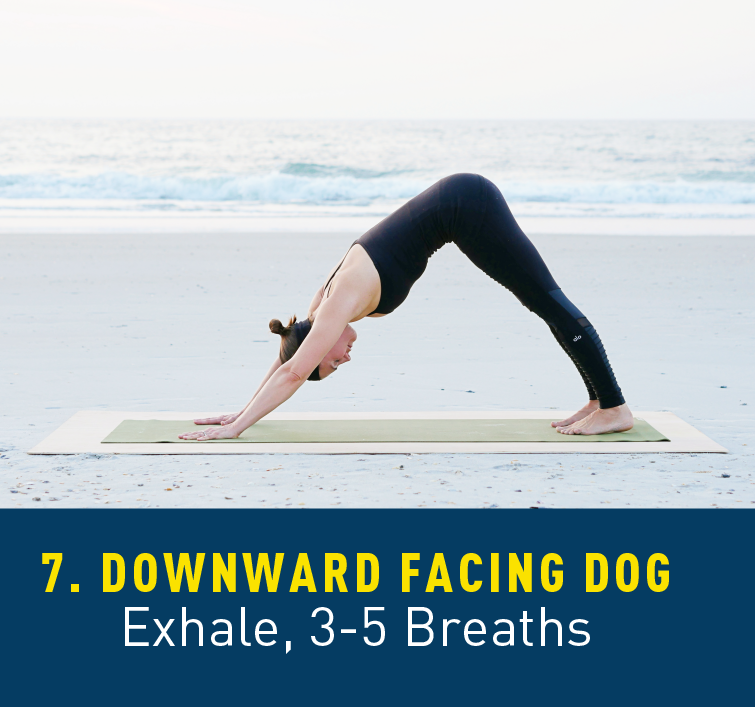
Downward Facing Dog
Hands shoulder-width apart or wider, feet hip-width apart. Root through the balls of the feet and the palms as the hips lift and the body becomes an inverted V shape. Make sure the wrist crease lines up with the front of the mat. Press the palms firmly into the ground, extend the arms fully, press the tops of thighs back.
Once the first sequence is complete, step feet forward to meet the hands, lift chest, fold, raise arms and return to mountain pose. Repeat as many times as you'd like.
Following the Sun Salutations, you can add other yoga postures into your practice or simply enjoy several breaths in Downward Facing Dog before transitioning to a deep relaxation in Corpse Pose.
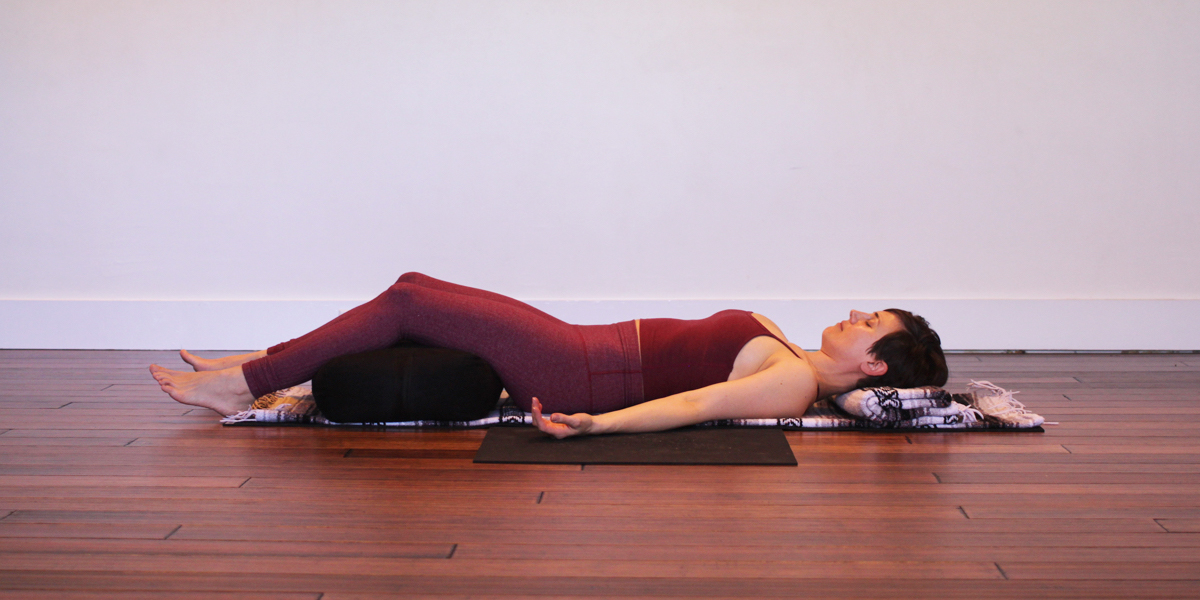
Corpse Pose: Shavasana
This might be one of the most important yogic postures, and yet possibly the most resisted because people erroneously think it’s “doing nothing.” This pose is not synonymous with sleeping (though you might fall asleep in it)! I’ll even go as far as to say that the busier your life and mind are, then the more important it is to practice Corpse Pose. Luckily, after a number of flowing Sun Salutations, most of us are ready for Corpse Pose!
To do Corpse Pose, lay on your back with your legs extended out long. Relax the legs naturally from the hips to the heels. Lay the arms down next to your sides with the palms facing up and have the head centered. Close your eyes and soften the entire body. Allow the breath to be natural. Take rest as each part of the body relaxes and softens toward the ground. (If the backaches when laying down, try placing a bolster under the knees and low thighs. You might also find a blanket useful for supporting the neck and head.) To receive the benefits of taking a purposeful relaxation, stay in this pose for five minutes or longer.
Give this combination of yoga concepts a try to invite both vigor and relaxation. Observe the effects of your yoga practice on your body and your mind. While exercise and stress reduction might assist in reducing inflammation, you may also find that the body is energized and craves healthier food, another way to reduce inflammation.
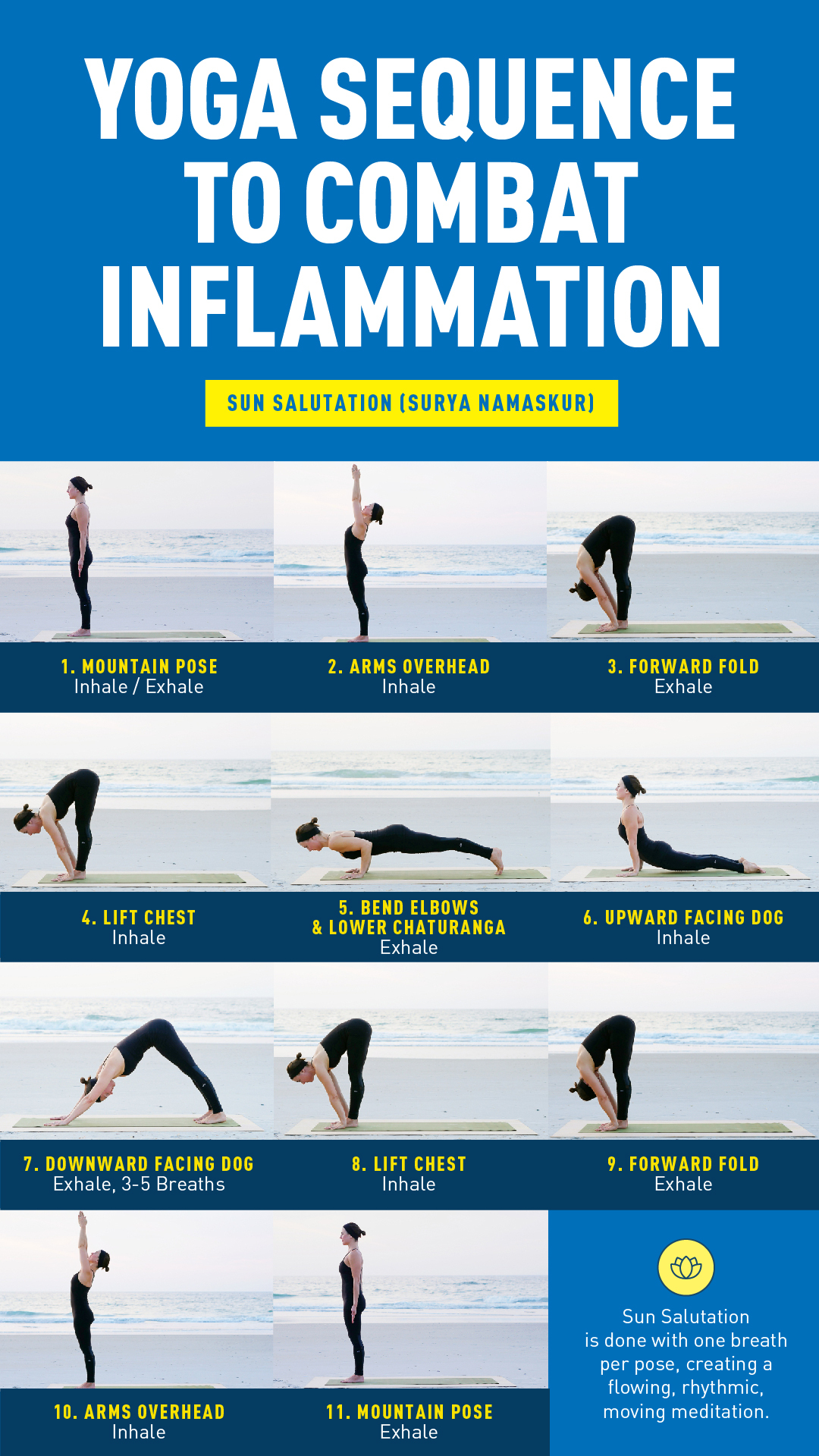
REFERENCES: 1. Djalilova DM, Schulz PS, Berger AM, Case AJ, Kupzyk KA, Ross AC. Impact of Yoga on Inflammatory Biomarkers: A Systematic Review. Biol Res Nurs. 2019;21(2):198-209. doi:10.1177/1099800418820162
1156-v2
Note that DTE products, including NP Thyroid®, have not been reviewed by the FDA for safety or efficacy.
IMPORTANT RISK INFORMATION, INCLUDING BOXED WARNING & INDICATIONS
Important Risk Information
Drugs with thyroid hormone activity, alone or together with other therapeutic agents, have been used for the treatment of obesity. In euthyroid patients, doses within the range of daily hormonal requirements are ineffective for weight reduction. Larger doses may produce serious or even life-threatening manifestations of toxicity, particularly when given in association with sympathomimetic amines such as those used for their anorectic effects.
- NP Thyroid® is contraindicated in patients with uncorrected adrenal insufficiency, untreated thyrotoxicosis, and hypersensitivity to any component of the product.
- In the elderly and in patients with cardiovascular disease, NP Thyroid® should be used with greater caution than younger patients or those without cardiovascular disease.
- Use of NP Thyroid® in patients with diabetes mellitus or adrenal cortical insufficiency may worsen the intensity of their symptoms.
- The therapy of myxedema coma requires simultaneous administration of glucocorticoids.
- Concomitant use of NP Thyroid® with oral anticoagulants alters the sensitivity of oral anticoagulants. Prothrombin time should be closely monitored in thyroid-treated patients on oral anticoagulants.
- In infants, excessive doses of NP Thyroid® may produce craniosynostosis.
- Partial loss of hair may be experienced by children in the first few months of therapy but is usually transient.
- Adverse reactions associated with NP Thyroid® therapy are primarily those of hyperthyroidism due to therapeutic overdosage.
- Many drugs and some laboratory tests may alter the therapeutic response to NP Thyroid ®. In addition, thyroid hormones and thyroid status have varied effects on the pharmacokinetics and actions of other drugs. Administer at least 4 hours before or after drugs that are known to interfere with absorption. Evaluate the need for dose adjustments when regularly administering within one hour of certain foods that may affect absorption.
- NP Thyroid® should not be discontinued during pregnancy, and hypothyroidism diagnosed during pregnancy should be promptly treated.
Indications
NP Thyroid® (thyroid tablets, USP) is a prescription medicine that is used to treat a condition called hypothyroidism from any cause, except for cases of temporary hypothyroidism, which is usually associated with an inflammation of the thyroid (thyroiditis). It is meant to replace or supplement a hormone that is usually made by your thyroid gland.
NP Thyroid® is also used in the treatment and prevention of normal functioning thyroid goiters, such as thyroid nodules, Hashimoto’s thyroiditis, multinodular goiter, and in the management of thyroid cancer.
Revised
10/2023
You Are About To Leave This Website
By clicking continue, this link will take you to a website to which Alora Pharmaceuticals’ Policies & Terms of Use do not apply.
^Based on prescriptions filled, NP Thyroid® is the #1 Prescribed DTE in the United States. Source: IQVIA National Prescription Audit (NPA) data on file. Acella Pharmaceuticals, LLC.
